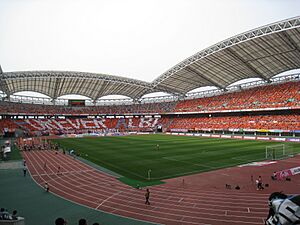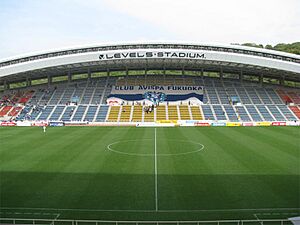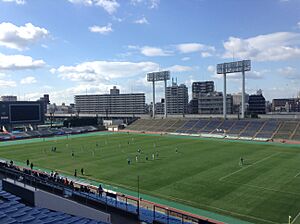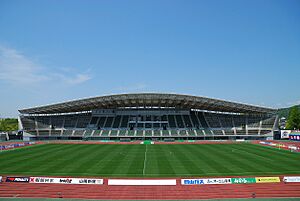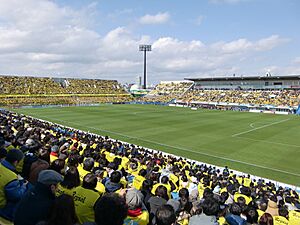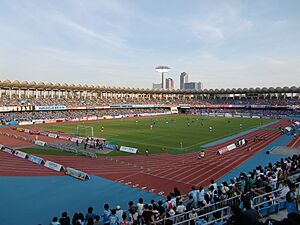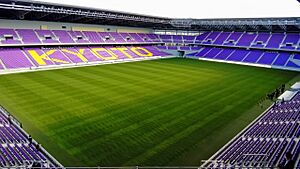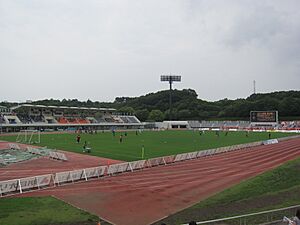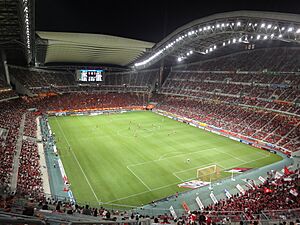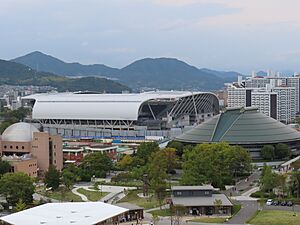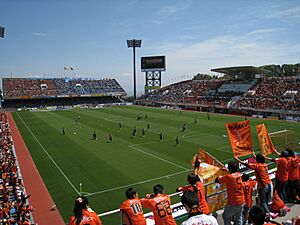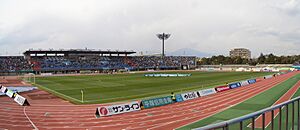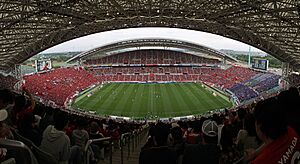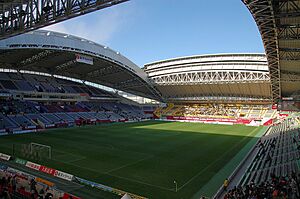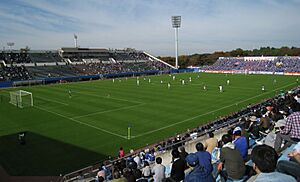J1 League facts for kids
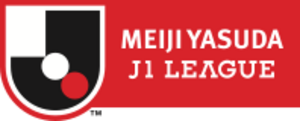 |
|
| Organising body | J.League |
|---|---|
| Founded | 1992 |
| Country | Japan |
| Confederation | AFC |
| Number of teams | 20 |
| Level on pyramid | 1 |
| Relegation to | J2 League |
| Domestic cup(s) | Emperor's Cup Japanese Super Cup |
| League cup(s) | J.League Cup |
| International cup(s) | AFC Champions League Elite AFC Champions League Two |
| Current champions | Vissel Kobe (2nd title) (2024) |
| Most championships | Kashima Antlers (8 titles) |
| Most appearances | Yasuhito Endō (672) |
| Top goalscorer | Yoshito Ōkubo (179) |
| TV partners | DAZN (including Abema de DAZN) NHK General TV (selected matches) NHK BS (selected matches) YouTube (selected matches and markets) |
The J1 League is Japan's top professional association football league. It is also known as the J.League or the Meiji Yasuda J1 League because of its main sponsor.
Twenty clubs compete in the J1 League. Teams can move between the J1 League and the J2 League through a system called promotion and relegation. This means that teams that do well in J2 can move up to J1, and teams that don't do well in J1 can move down to J2. Both leagues are run by the Japan Professional Football League.
The J1 League started in 1992. It is one of the most successful football leagues in Asia. From 1993 to 1998, it was simply called the J.League. Then, it became a two-division league and was known as J.League Division 1 until 2014. Vissel Kobe won their second straight title in the 2024 season, after winning in 2023.
Contents
History of the J1 League
How Japanese Football Became Professional
Before the J.League began, Japan had an amateur football league called the Japan Soccer League (JSL). It started in 1965. Even though many people watched games in the late 1960s and early 1970s, the JSL became less popular in the 1980s. There were not many fans, the stadiums were not great, and Japan's national team was not as strong as other Asian teams.
To make Japanese football better and more popular, the Japan Football Association (JFA) decided to create a professional league.
The Start of the J.League (1992-1995)
The professional J.League was formed in 1992. It started with ten clubs. Eight of these clubs came from the old JSL First Division, one from the Second Division, and a new team called Shimizu S-Pulse. The J.League officially kicked off its first season in early 1993.
Changes and Growth (1996-2004)
After a successful start, the number of fans at games dropped in 1996. To fix this, the league made big changes in 1999.
First, they launched the J.League Hundred Year Vision. This plan aimed to have 100 professional football clubs across Japan by 2092. Clubs were encouraged to connect with their local communities. They were asked to promote sports and health activities, get local sponsors, and build good relationships with their hometowns. This helped clubs rely on local support instead of just big national sponsors.
Second, the league changed its structure. It added nine clubs from the semi-professional Japan Football League and one club from the J.League to create a two-division system. The top league became J.League Division 1 (J1) with 16 clubs. The J.League Division 2 (J2) started with ten clubs in 1999.
From 1999 to 2004, the J1 season was split into two parts. The winners of each half played a final series to decide the overall champion. This split-season system was stopped in 2005.
European Style and Asian Success (2005-2008)
Since the 2005 season, the J1 League has had 18 clubs. The season format became similar to European football leagues. More teams were also moved between J1 and J2.
At first, Japanese teams did not see the AFC Champions League (ACL) as a very important competition. However, as the FIFA Club World Cup became more popular and Asian football grew, the J.League and its clubs started to focus more on Asian competitions. Japanese clubs like Urawa Red Diamonds (in 2007) and Gamba Osaka (in 2008) won the AFC Champions League. Because of this success, the AFC gave the J.League a high ranking. This meant four Japanese clubs could play in the AFC Champions League starting from the 2009 season.
Modern J1 League (2009-Present)
In 2009, more changes happened. Four clubs could now enter the AFC Champions League. Also, three teams were directly moved between J1 and J2. A new rule allowed clubs to have a fourth foreign player, as long as that player was from another Asian country.
In 2015, J.League Division 1 was officially renamed J1 League. The league briefly brought back the three-stage system for two seasons. This meant the season was split into two stages, followed by a championship playoff. However, fans did not like this format.
So, from 2017, the league went back to a single-stage system. The team with the most points at the end of the season is named the champion. Since 2018, the bottom two clubs are directly moved to J2. The 16th-placed J1 club plays a special match against the J2 playoff winner to decide which league they will play in next season.
Japanese clubs have also done well in international competitions. Urawa Red Diamonds won the AFC Champions League again in 2017. Kashima Antlers reached the final of the 2016 FIFA Club World Cup, becoming the first Asian club to do so.
Starting in the 2026–27 season, the J.League will change its schedule to run from August to May, like many European leagues.
Timeline of Key Events
| Year | Important events | No. J1 clubs | No. ACL Elite clubs | No. ACL Two clubs | Rel. slots |
|---|---|---|---|---|---|
| 1992 |
|
– | |||
| 1993 |
|
10 | |||
| 1994 |
|
12 | |||
| 1995 |
|
14 | |||
| 1996 |
|
16 | |||
| 1997 |
|
17 | |||
| 1998 |
|
18 | |||
| 1999 |
|
16 | 2 | ||
| 2003 |
|
||||
| 2004 |
|
0.5 | |||
| 2005 |
|
18 | 2.5 | ||
| 2007 |
|
||||
| 2008 |
|
2+1 | |||
| 2009 |
|
4 | 3 | ||
| 2015 |
|
||||
| 2016 |
|
||||
| 2017 |
|
||||
| 2018 |
|
2.5 | |||
| 2019 |
|
||||
| 2020 |
|
3 | 0 | ||
| 2021 |
|
20 | 4 | ||
| 2022 |
|
18 | 2.5 | ||
| 2023 |
|
1 | |||
| 2024 |
|
20 | 2 | 1 | 3 |
Team Logos
The 2025 Season
How the League Works
Twenty clubs play each other twice, once at home and once away. This means each team plays a total of 38 games.
- A team gets 3 points for a win.
- A team gets 1 point for a tie.
- A team gets 0 points for a loss.
Teams are ranked by their total points. If teams have the same points, these rules decide who is ranked higher:
- Goal difference (goals scored minus goals against)
- Goals scored
- Results in games played against each other
- Disciplinary points (fewer points for fouls and bad behavior)
If teams are still tied for first place, they are both declared champions. The top two teams will qualify for the next season's AFC Champions League Elite. The third-placed team qualifies for the AFC Champions League Two. The three teams at the bottom of the standings will move down to the J2 League.
- Prize money (2020 figures)
- Champions: 300,000,000 yen
- Second place: 120,000,000 yen
- Third place: 60,000,000 yen
The top 4 clubs also receive extra funds from the J.League:
- Champions: 1,550,000,000 yen
- Second place: 700,000,000 yen
- Third place: 350,000,000 yen
- Fourth place: 180,000,000 yen
Teams Playing in 2025
| Club | Year joined |
Seasons in J1 |
Based in | First season in top flight |
Seasons in top flight |
Current spell in top flight |
Last title |
|---|---|---|---|---|---|---|---|
| Albirex Niigata | 1999 (J2) | 16 | Niigata, Niigata | 2004 | 16 | 2023– | – |
| Avispa Fukuoka | 1996 | 13 | Fukuoka, Fukuoka | 1996 | 13 | 2021– | – |
| Cerezo Osaka | 1995 | 24 | Osaka & Sakai, Osaka | 1965 | 50 | 2017– | 1980 |
| Fagiano Okayama | 2009 (J2) | 0 | Okayama, Okayama | 2025 | 0 | 2025– | – |
| Gamba Osaka | 1993 | 31 | North cities in Osaka | 1986/87 | 37 | 2014– | 2014 |
| Kashima Antlers | 1993 | 32 | Southwestern cities/towns of Ibaraki | 1985/86 | 35 | 1993– | 2016 |
| Kashiwa Reysol | 1995 | 27 | Kashiwa, Chiba | 1965 | 51 | 2020– | 2011 |
| Kawasaki Frontale | 1999 (J2) | 21 | Kawasaki, Kanagawa | 1977 | 23 | 2005– | 2021 |
| Kyoto Sanga | 1996 | 14 | Southwestern cities/towns in Kyoto | 1996 | 14 | 2022– | – |
| Machida Zelvia | 2012 (J2) | 1 | Machida, Tokyo | 2024 | 1 | 2024– | – |
| Nagoya Grampus | 1993 | 31 | All cities/towns in Aichi | 1973 | 39 | 2018– | 2010 |
| Sanfrecce Hiroshima | 1993 | 30 | Hiroshima, Hiroshima | 1965 | 52 | 2009– | 2015 |
| Shimizu S-Pulse | 1993 | 29 | Shimizu, Shizuoka | 1993 | 29 | 2025– | – |
| Shonan Bellmare | 1994 | 17 | South and central cities/town in Kanagawa | 1972 | 35 | 2018– | 1981 |
| FC Tokyo | 1999 (J2) | 24 | Chōfu | 2000 | 24 | 2012– | – |
| Tokyo Verdy | 1993 | 15 | Tokyo | 1978 | 29 | 2024– | 1994 |
| Urawa Red Diamonds | 1993 | 31 | Saitama | 1965 | 57 | 2001– | 2006 |
| Vissel Kobe | 1997 | 26 | Kobe, Hyōgo | 1997 | 26 | 2014– | 2024 |
| Yokohama FC | 2001 (J2) | 4 | Yokohama, Kanagawa | 2007 | 4 | 2025– | |
| Yokohama F. Marinos | 1993 | 32 | Yokohama, Yokosuka & Yamato | 1979 | 44 | 1982– | 2022 |
- Pink background means the club was recently promoted from J2 League.
- "Year joined" is when the club joined the J.League (Division 1 unless noted).
- "First season in top flight", "Seasons in top flight", "Current spell in top flight", and "Last title" include seasons in the old Japan Soccer League First Division.
Stadiums for 2025 Season
| Albirex Niigata | Avispa Fukuoka | Cerezo Osaka | Fagiano Okayama | Gamba Osaka | Kashima Antlers | Kashiwa Reysol | |
|---|---|---|---|---|---|---|---|
| Denka Big Swan Stadium | Best Denki Stadium | Yanmar Stadium Nagai | Yodoko Sakura Stadium | City Light Stadium | Panasonic Stadium Suita | Kashima Soccer Stadium | Sankyo Frontier Kashiwa Stadium |
| Capacity: 42,300 | Capacity: 21,562 | Capacity: 47,816 | Capacity: 24,481 | Capacity: 20,000 | Capacity: 40,000 | Capacity: 37,638 | Capacity: 15,349 |
| Kawasaki Frontale | Kyoto Sanga FC | Machida Zelvia | Nagoya Grampus | Sanfrecce Hiroshima | Shimizu S-Pulse | Shonan Bellmare | |
| Kawasaki Todoroki Stadium | Sanga Stadium by Kyocera | Machida Gion Stadium | Paloma Mizuho Stadium | Toyota Stadium | Edion Peace Wing Hiroshima | IAI Stadium Nihondaira | Lemon Gas Stadium Hiratsuka |
| Capacity: 26,232 | Capacity: 21,600 | Capacity: 15,489 | Capacity: 27,000 | Capacity: 44,692 | Capacity: 28,520 | Capacity: 20,248 | Capacity: 15,380 |
| FC Tokyo | Tokyo Verdy | Urawa Red Diamonds | Vissel Kobe | Yokohama FC | Yokohama F. Marinos | All J1 Stadiums | |
| Ajinomoto Stadium | Saitama Stadium 2002 | Noevir Stadium Kobe | NHK Spring Mitsuzawa Football Stadium | Nissan Stadium | |||
| Capacity: 49,970 | Capacity: 63,700 | Capacity: 30,132 | Capacity: 15,454 | Capacity: 72,327 | |||
Former J1 Clubs
| Club | Year Joined |
Seasons in J1 |
Based in | First season in top flight |
Seasons in top flight |
Last spell in top flight |
Last title |
Current league |
|---|---|---|---|---|---|---|---|---|
| Hokkaido Consadole Sapporo | 1998 | 12 | Sapporo | 1998 | 12 | 2017–2024 | – | J2 |
| Júbilo Iwata | 1993 | 25 | Iwata, Shizuoka | 1993 | 25 | 2024 | 2002 | J2 |
| JEF United Chiba | 1993 | 17 | Chiba & Ichihara, Chiba | 1965 | 44 | 1965–2009 | 1985/86 | J2 |
| Matsumoto Yamaga | 2012 (J2) | 2 | Central cities/village in Nagano | 2015 | 2 | 2019 | – | J3 |
| Montedio Yamagata | 1999 (J2) | 4 | All cities/towns in Yamagata | 2009 | 4 | 2015 | – | J2 |
| Oita Trinita | 1999 (J2) | 11 | All cities/towns in Ōita | 2003 | 11 | 2019–2021 | – | J2 |
| Omiya Ardija | 1999 (J2) | 12 | Saitama | 2005 | 12 | 2016–2017 | – | J2 |
| Sagan Tosu | 1999 (J2) | 4 | Tosu, Saga | 2012 | 13 | 2012–2024 | – | J2 |
| Tokushima Vortis | 2005 (J2) | 2 | All cities/towns in Tokushima | 2014 | 2 | 2021 | – | J2 |
| V-Varen Nagasaki | 2013 (J2) | 1 | All cities/towns in Nagasaki | 2018 | 1 | 2018 | – | J2 |
| Vegalta Sendai | 1999 (J2) | 14 | Sendai, Miyagi | 2002 | 14 | 2010–2021 | – | J2 |
| Ventforet Kofu | 1999 (J2) | 8 | All cities/towns in Yamanashi | 2006 | 8 | 2013–2017 | – | J2 |
| Yokohama Flügels | 1993 | 6 | Yokohama, Kanagawa | 1985/86 | 11 | 1988/89–1998 | – | Defunct |
- Grey background means the club was recently moved down to J2 League.
- "Year joined" is when the club joined the J.League (Division 1 unless noted).
- "First season in top flight", "Seasons in top flight", "Last spell in top flight", and "Last title" include seasons in the old Japan Soccer League First Division.
League Statistics
All-Time J1 League Table
This table shows the total results for every team that has played in the J1 League up to the end of the 2022 season. Teams in bold are part of the 2025 J1 League.
Note: For these statistics, a win always counts as 3 points, a tie as 1 point, and a loss as 0 points. This is used even for seasons where the league had different point systems.
| Pos. | Club | Seasons | Pld | W | D | L | GF | GA | GD | Pts | Best Pos. |
|---|---|---|---|---|---|---|---|---|---|---|---|
| 1 | Kashima Antlers | 30 | 1024 | 561 | 155 | 308 | 1,749 | 1,211 | +538 | 1,838 | 1st |
| 2 | Yokohama F. Marinos | 30 | 1024 | 508 | 180 | 336 | 1,643 | 1,233 | +410 | 1,704 | 1st |
| 3 | Urawa Red Diamonds | 29 | 994 | 457 | 174 | 363 | 1,526 | 1,319 | +207 | 1,545 | 1st |
| 4 | Nagoya Grampus | 29 | 990 | 448 | 162 | 380 | 1,475 | 1,370 | +105 | 1,506 | 1st |
| 5 | Gamba Osaka | 29 | 990 | 445 | 155 | 390 | 1,640 | 1,459 | +181 | 1,490 | 1st |
| 6 | Shimizu S-Pulse | 29 | 990 | 421 | 167 | 402 | 1,415 | 1,459 | −44 | 1,430 | 2nd |
| 7 | Sanfrecce Hiroshima | 28 | 960 | 411 | 165 | 384 | 1,390 | 1,279 | +111 | 1,398 | 1st |
| 8 | Júbilo Iwata | 25 | 848 | 391 | 142 | 315 | 1,374 | 1,170 | +204 | 1,315 | 1st |
| 9 | Kashiwa Reysol | 25 | 842 | 363 | 144 | 335 | 1,261 | 1,217 | +44 | 1,233 | 1st |
| 10 | Kawasaki Frontale | 19 | 646 | 340 | 134 | 172 | 1,193 | 813 | +380 | 1,154 | 1st |
| 11 | FC Tokyo | 22 | 732 | 307 | 157 | 268 | 1,007 | 934 | +73 | 1,078 | 2nd |
| 12 | Cerezo Osaka | 22 | 744 | 306 | 133 | 305 | 1,117 | 1,120 | −3 | 1,051 | 3rd |
| 13 | Vissel Kobe | 24 | 794 | 266 | 163 | 365 | 1,056 | 1,250 | −194 | 961 | 3rd |
| 14 | JEF United Chiba | 17 | 578 | 227 | 70 | 281 | 874 | 980 | −106 | 751 | 3rd |
| 15 | Tokyo Verdy | 14 | 476 | 226 | 43 | 207 | 767 | 713 | +54 | 721 | 1st |
| 16 | Albirex Niigata | 14 | 472 | 156 | 115 | 201 | 557 | 679 | −122 | 583 | 6th |
| 17 | Shonan Bellmare | 15 | 532 | 166 | 83 | 283 | 663 | 908 | –245 | 581 | 5th |
| 18 | Vegalta Sendai | 14 | 472 | 144 | 122 | 206 | 561 | 686 | −125 | 554 | 2nd |
| 19 | Sagan Tosu | 11 | 378 | 133 | 107 | 138 | 443 | 479 | −36 | 506 | 5th |
| 20 | Omiya Ardija | 12 | 408 | 129 | 104 | 175 | 455 | 579 | −124 | 491 | 5th |
| 21 | Oita Trinita | 11 | 370 | 108 | 88 | 174 | 387 | 512 | −125 | 412 | 4th |
| 22 | Hokkaido Consadole Sapporo | 11 | 370 | 110 | 68 | 192 | 472 | 653 | −181 | 398 | 4th |
| 23 | Kyoto Sanga | 12 | 352 | 112 | 53 | 221 | 428 | 678 | −250 | 389 | 5th |
| 24 | Yokohama Flügels | 6 | 228 | 117 | 0 | 111 | 375 | 373 | +2 | 351 | 3rd |
| 25 | Avispa Fukuoka | 11 | 360 | 94 | 51 | 215 | 384 | 642 | –258 | 333 | 8th |
| 26 | Ventforet Kofu | 8 | 272 | 69 | 73 | 130 | 255 | 404 | –149 | 280 | 13th |
| 27 | Montedio Yamagata | 4 | 136 | 30 | 36 | 70 | 108 | 199 | −91 | 126 | 13th |
| 28 | Yokohama FC | 3 | 106 | 19 | 19 | 68 | 89 | 203 | −114 | 76 | 15th |
| 29 | Matsumoto Yamaga | 2 | 68 | 13 | 20 | 35 | 51 | 94 | −43 | 59 | 16th |
| 30 | Tokushima Vortis | 2 | 72 | 13 | 11 | 48 | 50 | 129 | –79 | 50 | 17th |
| 31 | V-Varen Nagasaki | 1 | 34 | 8 | 6 | 20 | 39 | 59 | −20 | 30 | 18th |
League or status at 2023:
| 2023 J1 League teams | |
| 2023 J2 League teams | |
| 2023 J3 League teams | |
| Defunct teams |
Championship Winners
Most Successful Clubs
Clubs in bold are playing in the J1 League for the 2025 season.
| Club | Champions | Runners-up | Winning seasons | Runners-up seasons |
|---|---|---|---|---|
| Kashima Antlers |
|
|
1996, 1998, 2000, 2001, 2007, 2008, 2009, 2016 | 1993, 1997, 2017 |
| Yokohama F. Marinos |
|
|
1995, 2003, 2004, 2019, 2022 | 2000, 2002, 2013, 2021, 2023 |
| Kawasaki Frontale |
|
|
2017, 2018, 2020, 2021 | 2006, 2008, 2009, 2022 |
| Júbilo Iwata |
|
|
1997, 1999, 2002 | 1998, 2001, 2003 |
| Sanfrecce Hiroshima |
|
|
2012, 2013, 2015 | 1994, 2018, 2024 |
| Gamba Osaka |
|
|
2005, 2014 | 2010, 2015, 2020 |
| Tokyo Verdy |
|
|
1993, 1994 | 1995 |
| Vissel Kobe |
|
|
2023, 2024 | |
| Urawa Red Diamonds |
|
|
2006 | 2004, 2005, 2007, 2014, 2016 |
| Nagoya Grampus |
|
|
2010 | 1996, 2011 |
| Kashiwa Reysol |
|
|
2011 | |
| Shimizu S-Pulse |
|
|
1999 | |
| Vegalta Sendai |
|
|
2012 | |
| FC Tokyo |
|
|
2019 |
Relegation History
Only four clubs have never been moved down from J1. Among these, only Kashima Antlers and Yokohama F. Marinos have played in every league season since 1993. The former J.League club Yokohama Flügels was never moved down before it merged with Yokohama Marinos in 1999.
JEF United Chiba holds the record for playing the longest time in the top league. They played for 44 seasons in a row in the top divisions of the JSL and J.League, from 1965 until they were moved down in 2009. The longest current streak belongs to Yokohama F. Marinos, who have played in the top league since 1982 (42 seasons in a row as of 2024).
- Summary of Relegation Rules
* Bold means clubs that were moved down;
† Won the Pro/rele Series or entry playoff;
‡ Lost the Pro/rele Series or entry playoff and were moved down
Other Football Tournaments
Domestic Tournaments
- Fujifilm Super Cup (since 1994)
- The JFA Emperor's Cup (since 1921)
- YBC Levain Cup (since 1992, except 1995)
International Tournaments
- FIFA Club World Cup (2007–2008, 2011–2012, 2015–2016)
- AFC Champions League (since 1969, with breaks)
Media Coverage
In Japan
DAZN has the exclusive rights to show all J.League matches online until 2033. Some matches are also available on Abema through a special DAZN plan.
For the 2024 season, certain matches were shown on NHK General TV and NHK BS. Some regional TV channels also showed games for their local teams.
Outside Japan
Selected matches are streamed worldwide on the J.League International YouTube channel, except in certain regions.
| Country/region | Broadcaster |
|---|---|
| Optus Sport | |
| Sportdigital | |
K-Ball
|
|
| TVB | |
| Indian subcontinent | Fancode |
| PSJ TV | |
| TDM | |
| Sporty TV | |
| Siam Sport (via AIS Play), BG Sports (via YouTube), and PPTV (terrestrial only) | |
| SCTV, HTV |
Sponsors
Main Partner
- Meiji Yasuda Life
Official Broadcasting Partner
- DAZN
Top Partners
- ÆON
- NTT docomo
- KONAMI
- Ichigo
League Cup Partner
Super Cup Partner
- Fujifilm Business Innovation
Equipment Partner
Sports Promotion Partner
Ticketing Partner
Online Shopping Partner
- Rakuten
Technology Partner
- NTT Group
Supporting Companies
- The Asahi Shimbun
- Deloitte
- IMAGICA GROUP
- LINE LY Corp
- Suntory Wellness
- Nikon
- TikTok
- Kearney
- Pony Canyon
See also
 In Spanish: J1 League para niños
In Spanish: J1 League para niños
- J.League records and statistics
- List of Japanese football champions
- Japanese association football league system
- WE League


